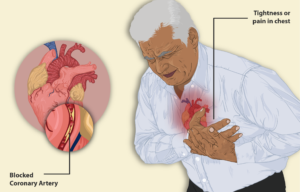Pain between shoulder blades can happen due to muscle strain, bone injuries, or other more severe conditions, including heart attack, gallbladder disease, or cancer. The cause of the pain, however, can be challenging to pinpoint.
To some, this is a sign that they have an undetected life-threatening condition and should visit an emergency room immediately. To others, this may also signify a problem with your spine or neck that needs immediate medical attention.
When it comes to shoulder pain, it’s kind of hard to find out the root cause. If you’re suffering from shoulder pain between your shoulder blade, there are a few possibilities. Shoulder pain is not just a straightforward lump in the muscle. The causes of shoulder pain can vary and tend to be more severe than they initially seem.
In this blog, our main concern is to point out the causes of pain between shoulder blades and its possible treatments. Some treatments are accessible at home to get instant relief and when it is the right time to see a doctor.
Table of Contents
Causes of pain between shoulder blades
Pain between shoulder blades tends to be caused by injury or strain to one of the major muscles in the back. The muscle affected will determine the exact type of pain you experience.
For example, a strained muscle in your trapezius region (upper back) will cause pain closer to your neck. Pain between the shoulder blade could also be from chronic strain or sprains in your rotator cuff or the large muscles surrounding that area.
Trauma
A severe injury such as joint separation, dislocation, or a fracture to one of the bones in the upper arm or scapula area can be pretty painful. This is especially true if any bleeding occurs.
When this happens, not only will pain between the shoulder blades develop, but swelling will also be present. A sports injury, a vehicle accident, or heavy lifting might all result in this kind of trauma.
Muscle Strains
One of the most common types of upper back pain between shoulder blades is caused by muscle strains. This strain may be the consequence of one of the following:
- Lifting or carrying heavy objects
- Poor posture
- Sleeping on a mattress that does not provide enough support
- Too much exercise or sports injuries
- Maintaining the same posture or position for a prolonged period

Arthritis
If you are experiencing pain between the shoulder blades due to arthritis in this area, you will notice a change in how you move your shoulder blade.
In most cases, there should be a loss of motion which causes shoulder blade pain. You may also notice that your arm is swollen or stiff to the point where it feels painful if it’s uncomfortable.
The common risks of arthritis include:
- Age factor
- Obesity
- Being female
Shingles
This condition can be painful when it causes a cluster of sores on your shoulder blade and the surrounding skin. When these areas become inflamed, the pain is usually quite severe.
Treating this condition as soon as possible is essential because you tend to experience continuous pain in these regions while inflamed.
Acid Reflux
Suppose you suffer back pain between shoulder blades due to acid reflux or Gastroesophageal disease (GERD). The odds are that this condition began due to smoking or drinking too much.
The stomach acid is being squeezed out of the lower part of your esophagus and into your shoulder region. You may also experience heartburn from this and possibly chest pain if you’ve suffered from reflux in the past.
Without proper treatment for GERD, it becomes difficult to sleep at night. If you have GERD symptoms regularly, you should see your doctor. A medical practitioner can prescribe anything to alleviate heartburn and, as a result, upper back discomfort.
Heart Attack
If you are having pain in the shoulder blade area, your priority is to find out if you have a heart attack. This could signify something serious if you experience tightness in the chest and shoulder region and an incredibly intense pressure sensation. You may also see other signs of a heart attack, such as sweating, dry mouth, light-headedness, nausea or vomiting.

Stress
If you have a history of low back pain, strain, or spasms in your back, then these symptoms may now be appearing in the shoulder area. Stress causes muscles to tense up, resulting in irritation and pain.
If a stressful situation has been going on for a prolonged period, you may notice back pain around the shoulder blades. This can be caused by muscular tension or injury.
The most common form of stress is the physical and emotional stress that comes with doing something challenging, like a long drive, surgery, or a project at work.
Scoliosis
Scoliosis is a condition that can be pretty severe if it occurs in this area. If you have scoliosis, there is a tendency for your spine to curve in one direction or another. This can cause pain between the shoulder blades and other areas, such as the midback and hips.
Exercise can help you develop the muscles in your upper back and shoulders, which will help you avoid muscle strain and soreness.
Pulmonary Embolism
When a pulmonary embolism occurs, you will feel pain in between shoulder blades that radiates down to your legs. You may notice that your starts to blur simultaneously and experience shortness of breath while taking deep breaths. Symptoms can be severe when this happens, but if it is not treated correctly.
Nerve Compression
Another frequent cause of interscapular discomfort is nerve compression, often known as a pinched nerve. When a nerve in the upper back feels pinched, it is known as thoracic radiculopathy. Sharp sensations between the shoulder blades, as well as chest discomfort, might result.
Cervical radiculopathy is a condition in which a nerve in the neck is squeezed, causing paralysis and loss of sensation in the arms and hands. The soreness may also spread between the shoulder blades.
Upper back pain between shoulder blades COVID
COVID has caused several underlining problems in our bodies. We were most likely not susceptible to such conditions earlier, but COVID negatively impacted our immune system and overall health.
Upper back pain between shoulder blades COVID can be one such condition you are going through as a side effect of the disease. If none of the above causes suit your case, COVID can be a reason for your discomfort.
The recommended treatment phase will involve light stretching and strengthening exercises for the muscles and ligaments in your upper back.
Your doctor may also recommend spinal manipulation therapy if these treatments are unsuccessful, another method for relieving discomfort in the shoulders and upper back.
When to see a doctor?
Upper back shoulder pain can become severe and life-threatening in some cases. If your pain is continuously increasing and you can’t find any relief, it is high time to see a doctor to discuss your symptoms and ask for treatments.
If you are facing severe pain between the shoulder blades and the following symptoms, it is critical to get medical help as soon as possible:
- Fever
- Nausea
- Sweating
- Fast heartbeat
- Coughing
- Impaired Vision
- Paralysis
- Unconsciousness
- Difficulty while speaking
- Shortness of breath
- Redness or swelling of feet and legs
Treatments of pain between shoulder blades
If your doctor determines that the source of your pain is not severe and requires a mild treatment plan, there are steps you can take at home to find pain relief. Below, we outline some simple ways to alleviate your interscapular pain:
Light Stretching
Gentle stretching techniques that may be helpful include those that involve:
- Arm circles
- Shoulders rolls
- Relaxation techniques
Stretching the upper back and neck can help promote relaxation and alleviate pain. These techniques are most successful if you practice them regularly.
If you are in pain when doing these techniques, you may suffer from a degenerative condition or scoliosis, but your doctor can mine this. You should also be aware that stretching isn’t a long-term solution for pain relief in this area of your body, so other techniques may need to be implemented if you’re looking for long-term relief from symptoms.

Exercise
Many people avoid exercise for fear of feeling pain in this area of their body. But it’s possible to perform specific activities to alleviate symptoms. Because these exercises consist of stretching and strengthening your muscles. So, they can be very effective at effectively relieving any pain that is present between your shoulder blades.

Massage
Massage therapy can help to relieve muscle tightness if you have a lot of tension in this region of the body or if it is otherwise uncomfortable.
At first, these techniques may feel painful, but as you become accustomed to the pressure being applied, you should notice an improvement in your pain levels.
Certain types of massage can help to increase blood flow which is vital to bettering your condition. Your therapist will be able to recommend massage techniques that are appropriate for you.

Diet
Some food and drink items may help reduce pain in the upper back. Some of these include water, fish oil supplements, and dark-colored berries.
Red wine can also help reduce pain levels between the shoulders if you drink it in moderation. Diet-rich resources like fruits, vegetables, legumes, and nuts. These things will naturally lower the in the body and inflammation too. To get better results, it is advised to avoid foods with high fat and salt content; one such thing is processed food.
Supportive Mattress
Some people report that sleeping on a firm mattress or even a yoga mat is beneficial for relieving pain in the upper back and shoulder blades. You may also benefit from sleeping on a firm mattress if you are menopausal or have increased body fat levels.
The most excellent mattress for back pain maintains the spine in a secure, neutral posture, allowing back muscles to relax and recuperate completely. When the spine is aligned with the hips and shoulders, and the joints are cushioned, you will sleep deeper and longer and wake up with less discomfort.

Final thoughts
If you are suffering from pain in this region of your body, your doctor will most likely be able to determine the cause. It would help to stay as active as possible because a sedentary lifestyle can worsen symptoms.
The recommended treatments will vary from person to person, but rest assured that your symptoms will subside quickly once treatment has begun.
While there may be no permanent cure for lower back pain, you can find relief by using these recommended treatments and following the guidelines regarding exercise and diet.
The pain in the upper back can be very uncomfortable and can happen due to several physical conditions. These include back pain, shoulder pain, and neck pain.
The pain may also be caused by several other states, including kidney stones, gallstones, stomach infections or ulcers, hernias, and slipped discs. You may not know what’s causing your pain, but you should research your condition for the latest treatments to see if any will help you feel better.

